Welcome to the vibrant world of dragon fruit, where colors and flavors collide! This guide delves into the 15 best varieties of this exotic fruit, Pitaya. If you want to add a touch of the extraordinary to your garden, you’re in for a treat. From the mesmerizing hues of its skin to the diverse tastes that await within, each dragon fruit variety offers a unique experience. Join us as we explore the spectrum of flavors and textures, and uncover the secrets to growing these captivating gems in your backyard.
What is Dragon Fruit?
Dragon fruit (Selenicereus undatus) is a cactus native to South America, Central America, and Asia. Also known as pitahaya, Pitaya, Belle of the Night, Cactus fruit, Kaktus madu, or Thanh Long, it has gained popularity in Southeast Asia, the Caribbean, Southern California, Texas, and Florida. Despite being appreciated as an ornamental plant due to its striking large blossoms, the fruit is a delicious treat. Initially green, it transitions to yellow or red based on its variety. This fast-growing plant offers visual allure to gardens and a flavorful, quick-to-mature fruit option.
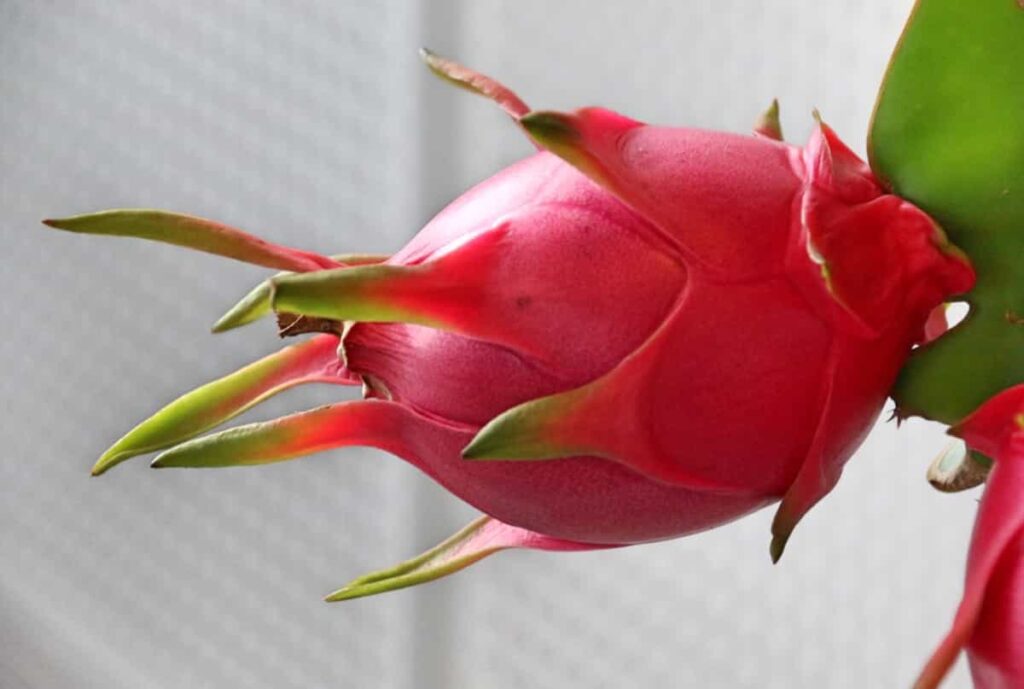
How to Grow Dragon Fruits in Your Gaden
- Climate and Location: You can grow dragon fruits outdoors year-round. For cooler regions, opt for potted dragon fruit plants that you can move indoors during winter. Even you can grow dragon fruit as a patio specimen.
- Temperature Requirements: Optimal temperatures for best harvest range between 65°F and 85°F. Protect your dragon fruit from temperatures below 32°F to prevent damage.
- Sunlight Exposure: Dragon fruit trees thrive in sunlight but tolerate partial shade around their roots. Ensure the foliage receives sunlight for 6 to 8 hours a day.
- Soil Conditions: Dragon fruit trees favor well-draining sandy soil. Avoid soil that retains excess water, as it can be fatal for the plant. soil pH of 6.0 to 7.0.
- Spacing and Growth Control: When planting in the ground, space the trees six feet apart and maintain nine feet between rows. For home gardens, you can manage growth by pruning and shaping.
- Planting Time: Early spring is suitable for planting dragon fruit in warm areas. In frost-prone areas, wait until frost risk has passed and temperatures average above 65°F.
- Planting Methods: Planting seeds is possible, but yielding fruit can take up to seven years. Sprinkle seeds on well-draining mix, lightly cover, and mist. Transplant seedlings when mature. Growing from cuttings is easier and faster. Plant a cutting in a container with good drainage.
- Container Planting: Choose a 10-gallon container with proper drainage. Use sandy cactus medium or well-draining potting mix. Support the plant with stakes or a trellis, especially since dragon fruit is a climber.
- Care and Maintenance: Feed with a liquid fertilizer every two months. Avoid overwatering and let the soil dry between waterings. Prune back larger varieties after a year of growth and a flowering season.
- Companion Plants: Surround dragon fruit with drought-tolerant plants such as Texas Sage, Ice Plant, Agave, and Yucca.
- Common Issues and Solutions: Inspect for stem rot; treat affected soil and remove rotting plants. Prevent anthracnose with well-draining soil and good airflow. Guard against birds with netting and deter ants with diatomaceous earth.
- Harvesting: Harvest ripe fruits when the skin turns red or white and is slightly soft. Twist or cut fruits from the plant. Store dragon fruit in the refrigerator for two weeks.
15 Best Varieties of Dragon Fruit
Selenicereus Chrysocardium (Golden Pitaya)
The Golden Pitaya, also known as the Golden Dragon Fruit, is a unique variety of dragon fruit with a striking appearance and blend of beauty and flavor. Its bright yellow skin adds a touch of sunshine to any garden, while its succulent and mildly sweet flesh melts in the mouth. The fruit’s distinctive aroma enhances the sensory experience, while its nutritional content includes antioxidants, vitamin C, and dietary fiber.
In case you missed it: How to Start Dragon Fruit Farming/Pitaya in Thailand: A Step-by-Step Guide for Beginners
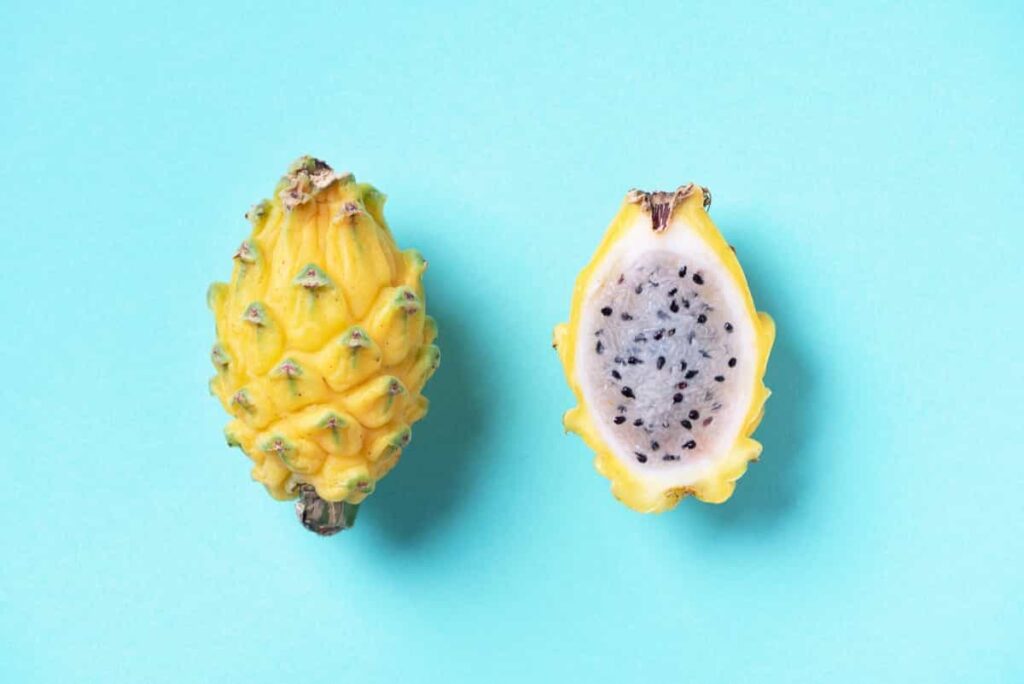
To cultivate the Golden Pitaya, ensure well-draining soil and a sunny spot in your garden. They thrive in warm climates, making them an excellent choice for tropical and subtropical regions. The fruit’s nocturnal blooming is a special feature, with its white blossoms releasing a sweet fragrance that attracts pollinators. The Golden Pitaya is also a culinary delight, with its vibrant color making it a great addition to fruit salads, smoothie bowls, desserts, and refreshing beverages.
Hylocereus Polyrhizus (Red-fleshed Pitaya)
Red-fleshed Pitaya, also known as Hylocereus polyrhizus, is a unique variety of dragon fruit with a striking outer appearance of vibrant pink to reddish skin. The inner flesh is rich, deep red, contributing to its distinctive flavor. The fruit has a unique balance of sweetness and a mildly tangy undertone, making it a delightful fusion of tropical fruits.
Its nutritional powerhouse provides dietary fiber, antioxidants, and essential vitamins like Vitamin C. Red-fleshed Pitaya’s bold color and flavor make it suitable for various culinary creations, from smoothies and salads to desserts and cocktails. Harvesting the fruit is a delight, as it is gently plucked from the plant when its skin color is vibrant and the fruit yields to pressure.
Hylocereus Megalanthus (Yellow Pitaya)
The Yellow Pitaya, also known as Hylocereus megalanthus, is a unique dragon fruit with a vibrant yellow exterior and elegant green scales. The flesh is snow-white and contains tiny black seeds, creating a delightful contrast. The taste is a symphony of sweet and slightly tangy notes with a subtly floral aroma.
This fruit thrives in warm climates and requires well-draining soil. It can be supported with trellises or stakes, similar to a climbing cactus. The Hylocereus megalanthus is a must-have for garden enthusiasts seeking exotic elegance and a burst of flavor in their green haven.
Selenicereus setaceus (Strawberry Pear)
Selenicereus setaceus, also known as the Strawberry Pear or Strawberry Cactus, is a unique member of the dragon fruit family with captivating characteristics. Its slender stems and spines contrast sharply with its vibrant reddish-purple flowers. The fruit, resembling a strawberry or pear, is smaller and has a rich magenta skin color.
It is a nocturnal bloomer, transforming your garden into a mystical oasis after sunset. Its fragrant flowers attract pollinators like moths and bats, making them essential to your garden’s ecosystem. Strawberry Pears are compact, ideal for smaller spaces and hanging planters. Their taste is a blend of strawberry and pear, with a refreshingly juicy flesh dotted with tiny black seeds.
Hylocereus Triangularis (Red Pitaya)
Hylocereus triangularis, also known as Red Pitaya, is a dragon fruit native to Central America, specifically Mexico and Nicaragua. Its distinctive appearance, featuring vibrant reddish-pink skin with scales, gives it an almost mythical appearance. The fruit’s unique taste is a blend of sweet and mildly tangy flavors. Red Pitaya is a nutritional powerhouse, rich in essential vitamins, antioxidants, dietary fiber, and vitamins C and B.
In case you missed it: Mastering the Dragon Fruit Orchard Management: A Month-by-Month Operations Guide for Maximum Yield
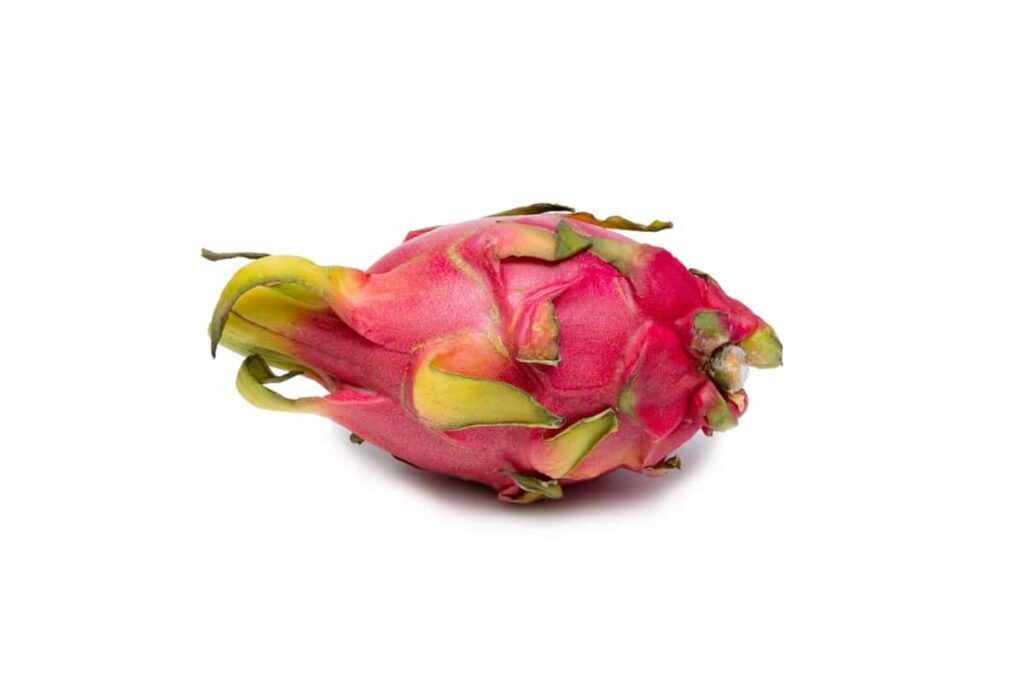
It thrives in warm climates with ample sunlight and is adapted well to dry conditions. The plant produces fragrant flowers that bloom at night, adding an extra touch of enchantment to gardens. Red Pitaya grows as a climbing cactus, requiring support for upward growth. Its color and distinct flavor make it a sought-after ingredient in culinary creations, including smoothies, salads, desserts, and cocktails.
Hylocereus Undatus (White-fleshed Pitaya)
White-fleshed Pitaya, also known as Hylocereus undatus, is a popular dragon fruit with distinctive pink to reddish exterior and green scales. Its inner flesh is sweet and hints of pear and kiwi, making it a tropical delight. White-fleshed Pitaya is rich in essential nutrients, including dietary fiber, vitamin C, and antioxidants, making it a healthy addition to any diet.
Its slightly sweet taste makes it a versatile ingredient in smoothies, salads, desserts, and savory dishes. The fruit is adorned with beautiful white blossoms that open at night, adding a subtle fragrance. Like all dragon fruits, White-fleshed Pitaya grows on climbing cacti, adding aesthetic appeal to gardens.
Hylocereus Costaricensis (Costa Rican Pitaya)
Costa Rican Pitaya, also known as Hylocereus costaricensis, is a unique dragon fruit with a striking appearance and subtly sweet taste. Its flesh is juicy and refreshing, with a hint of tropical sweetness. The fruit offers health benefits, including essential vitamins, minerals, and antioxidants.
In case you missed it: Plum Fruit Orchard Management: A Comprehensive Month-wise Maintenance Guide
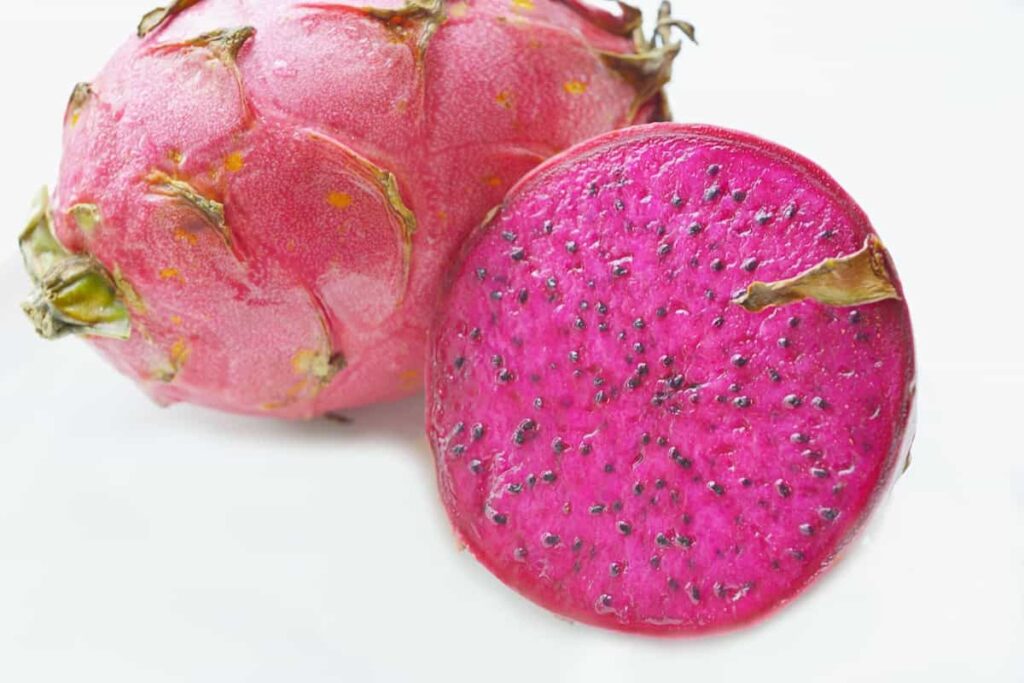
Its unique nocturnal blossoms, which unfurl during the evening, add a mystique to your garden. To cultivate Costa Rican Pitaya, ensure well-draining soil and ample sunlight. This adaptability makes it a favorite among gardeners looking to cultivate a slice of the tropics. The fruit’s versatility in culinary creations is evident, from dazzling fruit salads to crafting vibrant smoothie bowls.
Selenicereus Megalanthus (Giant Yellow Pitaya)
Giant Yellow Pitaya, also known as Selenicereus megalanthus, is a unique dragon fruit with a distinctive appearance and flavor profile. Its vibrant yellow skin and scales give it an exotic appeal. The fruit’s sweet and tangy taste is delightful, making each bite a tropical adventure. Its larger size adds grandeur to any garden and is a nutritional powerhouse, rich in antioxidants, vitamins, and fiber.
Cultivating this variety can be a rewarding experience, as it can be observed from vine to harvest. Its vibrant hue and unique taste make it versatile in culinary creations, from smoothie bowls to exotic fruit salads. Harvesting is a joyous process, with timing key to enjoying the peak flavors and textures. The fruit’s appeal is evident in its appearance, whether adorning a garden or featured in a fruit basket, infusing a touch of tropical elegance into any setting.
Hylocereus Purpusii (Purple Pitaya)
Purple Pitaya, also known as Dragon Fruit, is a unique and captivating cactus variety with a striking appearance and unique flavor. Its vibrant, magenta-hued skin and round-to-oval shape make it a standout in gardens. The fruit’s rich, deep purple flesh, contrasting with its exterior, offers a burst of color when sliced open. Its sweet flavor with a hint of earthiness makes it a favorite among fruit enthusiasts.
In case you missed it: 19 Best Cucumbers for Pickling: Top Crunchy Varieties to Grow in Your Garden
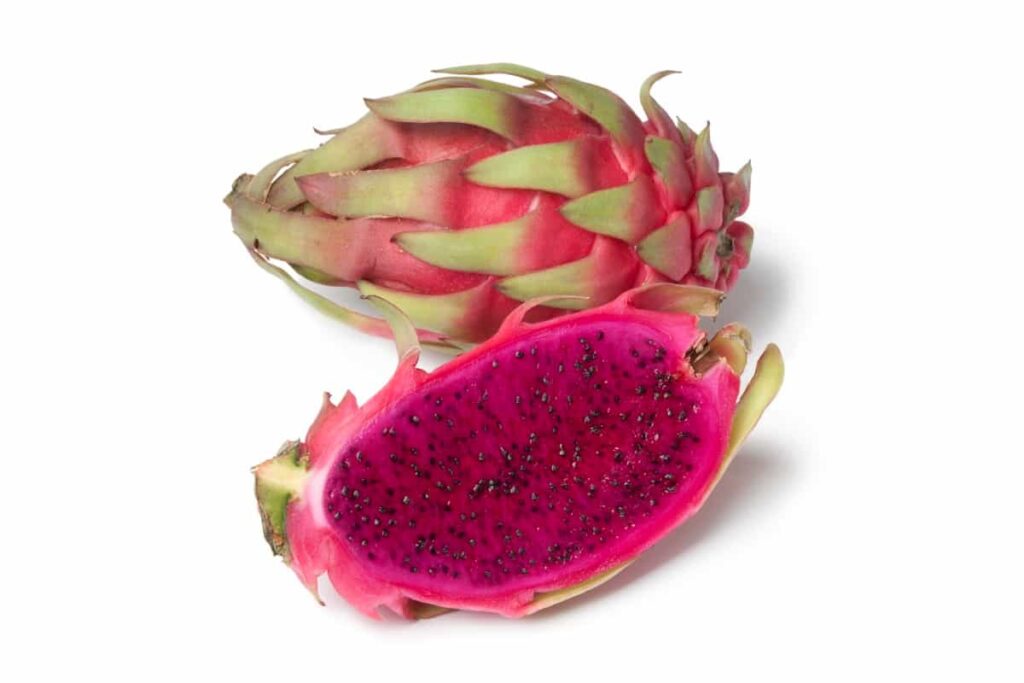
Purple Pitaya’s unique blend of flavors and adaptability to various climates and soil types make it a versatile addition to various regional gardens. Its visually appealing flesh can be used in various culinary creations, such as smoothie bowls and fruit salads. To grow Purple Pitaya, provide well-draining soil, ample sunlight, and occasional watering. Its ability to thrive in pots and gardens makes it an accessible option for gardeners of all skill levels.
Selenicereus Pteranthus (Night-blooming Cactus)
Selenicereus pteranthus, also known as the Night-blooming Cactus, is a captivating cactus variety with many captivating features. Its nocturnal beauty is a sight, with its stunning flowers evoking a delicate fragrance. Often white or pale, the flowers glow under the moonlight, creating an almost magical aura. Native to Central America and northern South America, this cactus thrives in various climates and environments. Its fruit is visually pleasing and deliciously sweet and refreshing.
In some cultures, the Night-blooming Cactus holds symbolic value, representing mystery, transition, and the beauty that emerges during the quiet hours of the night. Cultivating Selenicereus pteranthus can be a rewarding experience, especially when its flowers finally unfurl in the darkness.
Hylocereus Ocamponis (Ocamponis Pitaya)
Hylocereus ocamponis, commonly known as Ocamponis Pitaya, is a remarkable member of the dragon fruit family. This variety stands out with its vibrant pink to reddish skin and intriguing green scales. Its mesmerizing white flesh and subtly sweet taste set it apart, making it a delicacy. Ocamponis Pitaya’s unique characteristics include its ability to thrive in warm climates and well-draining soil. Its climbing nature and stunning night-blooming flowers add to its allure.
Selenicereus Grandiflorus (Queen of the Night)
Selenicereus grandiflorus, commonly known as “Queen of the Night.” This remarkable dragon fruit variety boasts striking attributes that captivate the eye and the palate. With its ethereal white blooms that bloom exclusively at night, it’s no wonder it’s earned its royal title. The fruit inherits this mystique, showcasing vibrant pink or yellow skin, concealing a sweet, flavorful pulp dotted with tiny edible seeds. A true nocturnal wonder, the Queen of the Night beckons those seeking a unique and alluring addition to their garden.
Hylocereus Stenopterus (Yellow Dragon Fruit)
Yellow Dragon Fruit (Hylocereus stenopterus) is a unique variety of dragon fruit known for its vibrant yellow skin, luscious sweet flesh, smooth flesh with edible black seeds, and subtly floral aroma. It is a nutritional powerhouse rich in antioxidants, vitamins, and dietary fiber, contributing to a healthy diet.
In case you missed it: 10 Best Companion Plants for Carrots: What Not to Plant With Carrots
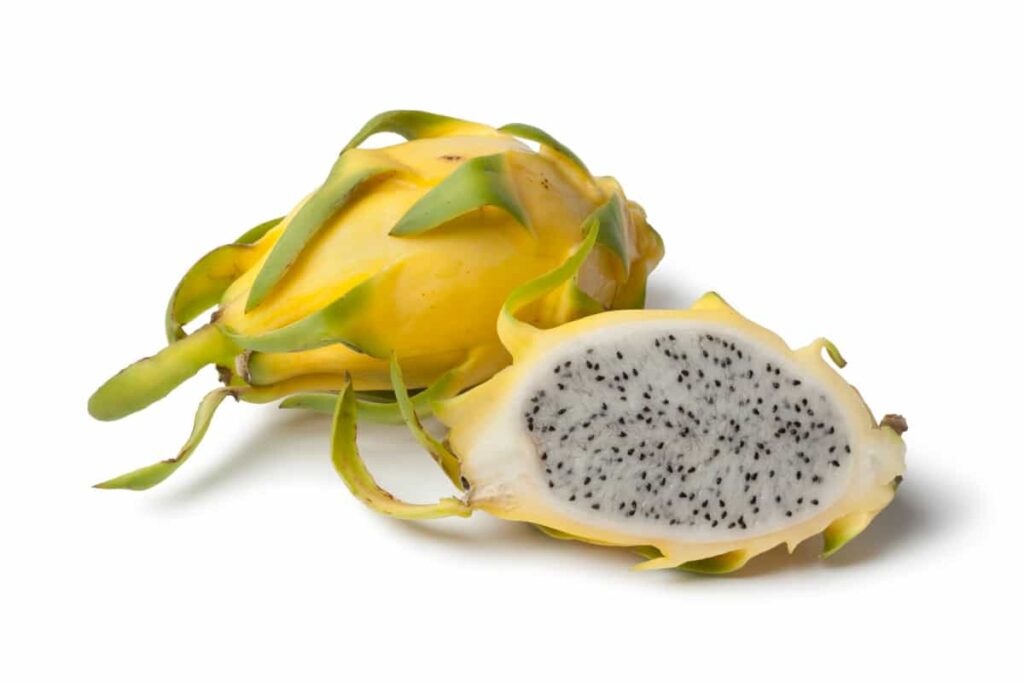
Growing in warm climates requires well-draining soil and sunlight. Yellow Dragon Fruit’s unique appearance makes it a great choice for garden decorations and culinary presentations. Its versatility makes it a favorite among food enthusiasts. Harvesting occurs when the fruit turns fully yellow and slightly soft.
Selenicereus Hamatus (Hamatus Pitaya)
The Hamatus Pitaya is a unique dragon fruit with deep pink to red skin and white flesh inside. Its sweet and mildly tangy flavors are delightful, and its smooth texture is crunchy. The fruit’s uniqueness lies in its ability to thrive in warmer climates, making it a popular choice for gardeners seeking tropical allure.
Hylocereus Calcaratus (Calcaratus Pitaya)
Calcaratus Pitaya, or Hylocereus calcaratus, is a dragon fruit with vibrant green skin and magenta splashes. Its sweet, mildly tangy flesh is punctuated with edible black seeds. The fruit’s unique features include its natural pigmentation, making it a stunning ornamental addition and a delectable treat. Its texture is a harmonious blend of smoothness and juiciness, offering a refreshing experience on a warm day. Its sweet flavor profile is a perfect balance of indulgence and healthiness. Growing Hylocereus calcaratus is a rewarding endeavor due to its rapid development pattern.
Conclusion
Dragon fruit offers a kaleidoscope of flavors and colors to elevate your garden. From the vibrant hues of skin to the delectable tastes within, each variety brings its unique charm. Embark on this fruitful adventure and transform your garden into a haven of exotic delights.
- Crops Grown in Summer Season: Best Choices for Summer Gardening
- Organic Pest Control for Tomato Farming
- How to Maximize Sheep Farming Profit
- Broccoli Varieties: Choosing the Right Cultivars for Your Farm
- How to Raise Pigs in Your Own Backyard: A Comprehensive Guide
- Budget Friendly Sheep Shed Ideas: Cheap and Low-Cost Tips
- How Much Do Cattle Farmers Make: Revenue Streams in Cattle Farming
- Management Pests and Diseases in Your Cotton Field
- Sheep Farming Business Plan for Beginners
- Aquaponic Farming at Home: A Step-By-Step Guide
- Profitable Village Farming Business Ideas in 2024
- High-Yield Aquaculture: Fast-Growing Fish for Farming
- Effective Fish Pond Construction Techniques for Beginners
- Irrigation and Water Management in Pineapple Farming
- Blossom to Harvest: Mastering Flowering and Pollination in Papaya Farming
- Pig Fattening Essentials: From Selection to Sale for Beginners
- Raising Wagyu Cattle: A Complete Guide for Premium Beef Production
- Soil Types and Their Water Holding Capacity
- Optimizing Irrigation Schedules for Coconut Groves for Enhanced Yield
- Espresso Your Garden: Coffee Grounds for Healthier Acid-Loving Plants
- The Best Soil Mix for Snake Plants: How to Mix Your Own Snake Plant Soil
- Green Thumb Success: Expert Tips for Cultivating Greenhouse Beans All Year Round
- Bloom All Year Round: The Ultimate Guide to Indoor Hyacinth Care
- Eco-Friendly Gardening: How to Make Liquid Fertilizer from Kitchen Waste
- Ultimate Guide to Grow Anise in Pots: Explore Seed Propagation to Harvesting
- Guide to Raising Chester White Pigs: Discover Breed Facts to Growth Management
- Mastering the Elegance: The Ultimate Guide to Weeping Cherry Tree Care, Planting, and Maintenance
- Ultimate Guide to Planting Garlic in Grow Bags: Growing Strategies for Beginners
- How to Fix Spider Plant Leaf-Related Problems: Natural and Organic Remedies
- 10 Reasons Why Your Tulsi Plant is Shedding Leaves: Home Remedies and Solutions
- Optimizing Growth and Yield: The Advantages of Palm Bunch Ash Fertilizer
- Utilizing Neem Oil Extract as a Natural Pesticide for Hydrangea
- From Soil to Harvest: Various Ways in Which Farmers Can Use AI Tools
- Steps to Encourage and Induce Citrus Flowers: A Comprehensive Guide
- How to Fix Snake Plant Leaf-Related Issues: Natural and Organic Remedies
- Transform Your Garden into a Fragrant Oasis with Raat Ki Rani (Night Blooming Jasmine)
